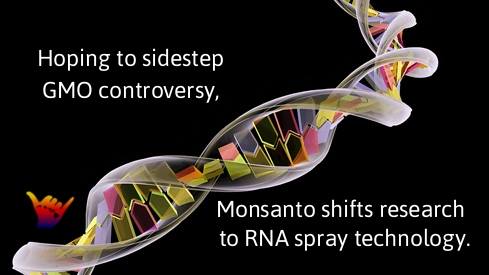As Scotland moves forward to ban genetically modified crops, Monsanto is developing a way to alter crops without touching their genes.
Through RNA interference, or the process of temporarily barring gene expression, Monsanto scientists have been able to stop the Colorado potato beetle from eating crops. Instead of modifying the crop’s genes, they’ve sprayed RNA that shuts down a gene the insects need to survive directly onto the crops. When the beetles eat the plant, the ingested RNA will eventually cause them to die through inhibiting the necessary gene.

Antonio Regalado, reporting at MIT Technology Review, explains RNA interference further:
The mechanism is a natural one: it appears to have evolved as a defense system against viruses. It is triggered when a cell encounters double-stranded RNA, or two strands zipped together—the kind viruses create as they try to copy their genetic material. To defend itself, the cell chops the double-stranded RNA molecule into bits and uses the pieces to seek out and destroy any matching RNA messages. What scientists learned was that if they designed a double-stranded RNA corresponding to an animal or plant cell’s own genes, they could get the cells to silence those genes, not only those of a virus.
Other companies, all of which are hoping to avoid the controversy they face when they genetically modify crops directly, are exploring the genetic spray alternative to GMOs. These sprays can be created and applied quickly, providing protection if the plants are infested by a never-before-seen virus or insect. They could even be used to endow plants with advantageous, temporary traits. For example, farmers could spray RNA is that bestow corn plants with drought-resistance, saving a harvest during hot, dry weather.
Such sprays can only turn off genes for a few days or weeks at a time, so all efforts would be temporary. If a new set of insect invaders enters the field of crops weeks after the last RNA spray, the plants would no longer be protected. But the approach has it’s benefits, too, because the plants’ genes that were affected to help them survive in a water shortage would revert back to their original states when the water shortage ends. This means they could thrive in both conditions. In addition to that, if insects evolve to survive the RNA spray, the scientists could switch which gene they’re affecting. Monsanto is hoping to improve the sprays to last for months—some scientists have already been successful in creating these long-lasting sprays.
Since the spray target specifics genes that only that certain targeted insects have, it wouldn’t affect beneficial bugs that currently suffer from pesticide use, such as bees. This differentiates the spray from traditional insecticides, which are indiscriminate killers.
Despite the lack of evidence of harmful effects of the spray, it will most likely face stiff opposition. Some worry the spray will be hard to control, and wind could blow it to surrounding areas. Others argue that the RNA interference might silence important genes in humans when we eat the crops, but no trustworthy studies so far have shown that to be true.
@ pbs.org
The Next Great GMO Debate
Deep inside its labs, Monsanto is learning how to modify crops by spraying them with RNA rather than tinkering with their genes.
The Colorado potato beetle is a voracious eater. The insect can chew through 10 square centimeters of leaf a day, and left unchecked it will strip a plant bare. But the beetles I was looking at were doomed. The plant they were feeding on—bright green and carefully netted in Monsanto’s labs outside St. Louis—had been doused with a spray of RNA.
The experiment took advantage of a mechanism called RNA interference. It’s a way to temporarily turn off the activity of any gene. In this case, the gene being shut down was one vital to the insect’s survival. “I am pretty sure 99 percent of them will be dead soon,” said Jodi Beattie, a Monsanto scientist who showed me her experiment.
The discovery of RNA interference earned two academics a Nobel Prize in 2006 and set off a scramble to create drugs that block disease-causing genes. Using this same technology, Monsanto now thinks it has hit on an alternative to conventional genetically modified organisms, or GMOs. It can already kill bugs by getting them to eat leaves coated with specially designed RNA. And if the company succeeds in developing sprays that penetrate plant cells, as it’s attempting to, it could block certain plant genes, too. Imagine a spray that causes tomatoes to taste better or helps plants survive a drought.
Monsanto isn’t the only one working on genetic sprays. Other large agricultural biotech companies, including Bayer and Syngenta, are also investigating the technology. The appeal is that it offers control over genes without modifying a plant’s genome—that is, without creating a GMO.
That means sprays might sidestep much of the controversy around agricultural biotechnology. Or so companies hope. What’s certain is that a way to accomplish the goals of genetic engineering without having to develop a GMO could bring commercial rewards. Sprays might be quickly tailored to do battle with an insect infestation or a new type of virus. Not only could this be faster than creating new GM crops, but the gene-silencing effects of RNA interference last only a few days or weeks. That means you might spray on traits such as drought resistance in times of water shortage without affecting the plant’s performance in times of normal rainfall.
Beattie showed me a large glass jar in which dried, purified RNA glistened like crumbled packing peanuts. A few years ago, this much RNA might have cost $1 million, one reason few would have thought to spray it from tractors rumbling through rows of corn. But the cost of making RNA has plummeted. Monsanto estimates that it now costs $50 a gram. A tenth that amount, the company says, is potent enough to kill 100 percent of beetles on an acre of plants.
Monsanto has spent millions learning how to control plant traits using genetic sprays. Opponents see a new risk.
At Monsanto I met Robb Fraley, the company’s chief technology officer, who oversees a research staff of 5,000. Three years ago Fraley designated the RNA sprays as one of Monsanto’s new areas for product development. He thinks that within a few years they will “open up a whole new way to use biotechnology” that “doesn’t have the same stigma, the same intensive regulatory studies and cost that we would normally associate with GMOs.” He’s told people he thinks the tools are “incredible” and “breathtaking” and that “of all the platforms we are working on, this is the one that reminds me the most of the early days of biotech.”
It was Fraley who made Monsanto’s first GM plants in the 1980s—petunias resistant to a plant poison. Today, Monsanto has revenues of about $9 billion a year from GM seeds for crops that produce the insect toxin Bt or resist the weed killer Roundup. GM corn, soy, and cotton plants now spread across 180 million hectares. And it has generated a public controversy just as vast. To its strongest critics, the company is simply “Monsatan.”
But with the RNA spray technology, which Monsanto calls BioDirect, the company may have found something that will bedevil opponents. The sprays are made from a ubiquitous molecule that degrades quickly in soil. They can be genetically precise enough to kill potato bugs but spare their ladybug cousins. And so far, consuming RNA molecules appears no more toxic to people than drinking a glass of orange juice. As Monsanto put it in a letter to U.S. regulators, “humans have been eating RNA as long as we have been eating.”
Public opposition, regulations, and the slow pace of plant breeding mean that on average, bringing a new GM crop to market costs more than $100 million and takes around 13 years. But imagine you wanted to fight a plant virus, says James Carrington, head of a Missouri nonprofit called the Danforth Plant Science Center and an advisor to Monsanto. “If you can gain control with a spray, you can envision a product that can change very rapidly, that you can test faster, experiment with faster, and bring to market faster,” he says. “You could respond to issues as they arise.”
Not everyone is convinced, though, that applying RNA will be commercially feasible or any less controversial than genetic modification. “The public is not accepting GMOs, and this could be more alarming. People are going to say you are taking the RNA and spraying this in the open,” says Kassim Al-Khatib, a plant physiologist at the University of California, Davis. “The acceptance of biotech has to be there before you can deliver another approach. This isn’t a technology for tomorrow. It’s for the day after tomorrow.”
Sprays might be quickly tailored to do battle with an insect infestation or a new type of virus.
When I met Fraley, he didn’t deny that there are obstacles—in fact, that’s what reminds him so much of biotech’s early days. He says no one yet understands exactly how to get RNA inside a plant’s cells using a field sprayer—at least not with the sort of inexpensive, works-every-time efficiency farmers would be looking for. Many insects are also not easily affected. Monsanto has been spending millions to crack these problems, collaborating with biotech companies specializing in drug delivery. “We’re still a few breakthroughs away,” he says.
Weed control
The cells of plants and animals carry their instructions in the form of DNA. To make a protein, the sequence of genetic letters in each gene gets copied into matching strands of RNA, which then float out of the nucleus to guide the protein-making machinery of the cell. RNA interference, or gene silencing, is a way to destroy specific RNA messages so that a particular protein is not made…

